Following a catastrophic storm on Feb. 13 that left over 530,000 homes in the dark, Victoria’s most extensive power blackout has prompted a comprehensive review to investigate its root cause and scrutinise the state’s infrastructure resilience and emergency preparedness.
The review, initiated into the operational response of electricity companies, comes in the wake of severe storms that swept across the state, damaging over 12,000km of powerlines and poles.





